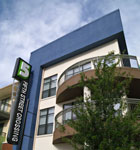We started the repavement process by doing an extensive survey of the track. We tried to figure out exactly what was there—what the banking was and what the transitions were coming in and out of the turns. From the survey we generated a computer model and ran simulations to get an idea of what was going to happen when we repaved the track and what it would do for the racing. In the case of the Phoenix, we found out if we just repaved it, we’d be back to a single-file race for the next five to six years until the lower grooves started wearing out. That was not what we looking for.
We looked at ways to alter the track to have good, competitive racing. As we began going through iteration after iteration of changes to the track, we ended at over 20 iterations to get the track where we needed and wanted it. We settled on a variable-bank scenario, where turns one and two and the dogleg had 10- and 11-degree banking and turns three and four had 8- and 9-degree banking. We pushed the track back about 95 feet further south of its original position. It picked up 4 feet in vertical elevation, so the track was sitting on a higher plain than it was before. All those little things got us to where we wanted to be in terms of competitive racing, and it helped the sight line from the grandstand.

Track modifications required additional work to be done on the inside and outside of the raceway. There were a lot of little pieces of the puzzle that—after we got the banking solution worked out—needed to be adjusted before the track was in racing condition again. The walls needed to be extended in turns one, two, three, and four because the grade was brought up. By making the walls taller, most of the fencing came down and needed to be reconstructed around the track. We had to move and then rehang the lights on the interior and exterior, positioning them to shine on the new track and the new banking configuration.
With the changes made, we ensured we’d get good, competitive racing on day one. Fans coming to the track were able to watch quality racing immediately following the repave. By picking up and raising the track, the spectators were able to see as much of the track, if not more, than they saw before. In most cases the seats had better sight lines than prior to the repaving; fans are able to follow the cars longer around the track.
A handful of contractors were involved in the repavement project. The project started March 1, 2011; on August 29, construction was complete. Goodyear spent the month of September testing, [and] the track was ready by November 1. Howard S. Wright Construction [Co.] was the general contractor on the project. They managed the job and were responsible for lining up the subcontractors. Ajax Paving Industries, Inc., a company out of the Michigan area, was our main paving contractor. We went through a screening process and chose Ajax for the job. They did an outstanding job. We got a racetrack that met our specifications and exceeded our expectations. The contractor that demoed and graded everything was Markham Contracting Co., Inc. Smith Fencing took down and put up all the fencing. Southern Bleacher added a new mile of wall on the outside and inside of the track.
The hardest part of doing a track-paving project is having patience. We went through an intensive testing process to make sure the material being produced at the plant was correct, to ensure the placement was being done right, and to verify the density was where it was supposed to be. The pavement process is slow and takes a lot of patience by all involved. ABQ


